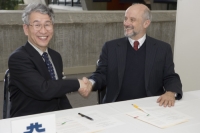Director's Corner
26 April 2007
 Barry Barish |
KEK and Fermilab: Strengthening collaborations
Two of our principle collaborating institutions in the ILC are KEK Laboratory in Tsukuba, Japan and Fermilab in Batavia, Illinois. This week the KEK Director General, Atsuto Suzuki, came to Fermilab to discuss increased collaboration. Atsuto Suzuki is a very distinguished physicist, whom I have known for many years due to our mutual histories in neutrino physics. I note and congratulate him for recently being awarded the prestigious Bruno Pontecorvo Prize in recognition of his contribution to the “Discovery of Reactor Antineutrino Oscillations and Detection of Geoantineutrinos in the KamLAND experiment.” Atsuto's Fermilab visit resulted in a newly signed MOU (Memorandum of Understanding) between the two laboratories. This growing partnership is a very positive development for high energy physics, especially for the ILC where so much of our programme and ambitions rest with these two large laboratories. During the visit, Atsuto and I were also able to have a very productive meeting, where we candidly discussed many issues related to moving the ILC forward in the coming years.
The Japanese delegation had a whirlwind tour of Fermilab, met with several experimental groups and toured the major facilities at the laboratory, including the collider detectors, the accelerator facilities, neutrino experiments and the ILC superconducting RF test facilities. KEK and Fermilab signed a new MOU that has a special emphasis on mutual interests and will help facilitate joint work and exchanges in neutrino physics and accelerator development, including the ILC. This visit to Fermilab was actually a return visit, following an earlier visit by the Fermilab upper management to KEK and to JPARC last fall.
My separate meeting with Atsuto was very useful. We were able to quietly discuss many topics related to moving the ILC forward, including the Japanese HEP plans and their potential role in the ILC. At this point in time, the first priority in Japan is to successfully complete the JPARC project, and to begin its operations. The Japanese involvement in ILC R&D and engineering design must be consistent with that priority and is also integral to future plans for accelerator R&D at KEK. We talked about the purpose and goals of the GDE ILC engineering design and how our effort can best take into account the needs in Japan. The steps and requirements to become a construction project in Japan are quite different from the US or Europe. We agreed that we must find common ground, where our accomplishments during the GDE engineering phase will provide what will be needed for all our collaborating countries.
The Japanese system does not require a detailed engineering design to obtain project approval; however a reliable total cost must be established. In contrast, the US system in the Department of Energy has a stepwise set of design steps (Conceptual Design 0, Conceptual Design 1, etc), and at each level designated design details must be accomplished. We are working to define our next big step such that it will move us forward as effectively as possible in both systems, as well as in the rest of our collaborating countries.
In our discussions this week at Fermilab, we acknowledged the strong KEK role in ILC R&D, especially on superconducting R&D, final focus tests at ATF-2 and perhaps also on electron cloud effects. The emphasis at Fermilab will be more on the engineering design, but they are also developing superconducting RF infrastructure and tests. Clearly, the GDE has the crucial role of coordinating these efforts such that we develop unified designs of ILC components that will be buildable in both Japanese and US industry.
-- Barry Barish

